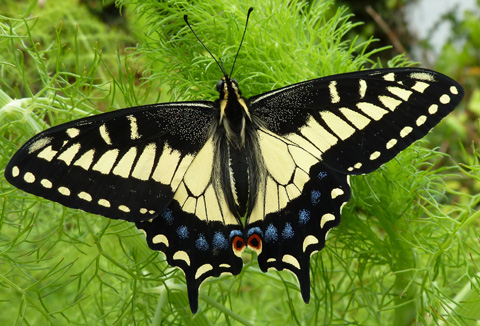 Santiago Truck Trail, Orange County, CA. 4/25/09. © Peter J. Bryant |
Anise swallowtail Papilio zelicaon Lepidoptera: Papilionidae Back to Butterflies of Orange County, California |
||||||||||||
 © Robert Gorman |
 San Mateo State Park, Orange County, CA. 3-1-12. © Robert Gorman |
||||||||||||
 © Robert Gorman |
 © Robert Gorman |
||||||||||||
 Egg |
 First-instar larva |
||||||||||||
 Second-instar larva |
 Third-instar larva |
||||||||||||
 Fourth-instar larva with everted osmeteria |
 Fifth-instar larva just molted |
||||||||||||
|
|||||||||||||
Characteristics: Dorsal wing with black and yellow markings, but with more black and less yellow than Papilio rutulus. Similar Species: Western Tiger Swallowtail (Papilio rutulus). Habitats, Behavior: Often found in proximity of foodplant; hilltops on the higher peaks (Modjeska and Santiago) of the Santa Ana Mountains. Pyle (1974) lists other behavior: remaining in one area prior to mating, and frequently visiting mud puddles. Distribution: This swallowtail occurs primarily in semidisturbed land areas at low elevations. It is occasionally encountered hilltopping on our mountain peaks. Flight Period: Multiple brooded in Orange County. Our records extend from February to September, although the species may occur throughout the year. It appears to be particularly abundant from April to June. Larval Foodplants: Sweet Fennel, sometimes called Wild anise (Foeniculum vulgare) is probably the most frequently utilized foodplant in Orange County. In the Santa Ana Mountains, additional umbelliferous foodplants may be utilized: Tauschia arguta, Lomatium dasycarpum, L. utriculatum and Oenanthe sarmentosa. Citrus is also utilized (which is a member of the plant family Rutaceae, rather than Umbelliferae) and larvae have been known to cause economic damage in citrus groves. The Anise Swallowtail may utilize plants of these two rather unrelated families because of similar compounds found in both. Anise aldehyde (see below) is found in some umbelliferous plants whereas citrus contains a similar substance, methyl clavicol. Both may function as behavioral attractants, i.e. substances which may hold no nutritive value, but whose presence is necessary, either to stimulate egg-laying by the adult on the plant or to stimulate feeding by the larvae. Other Remarks: The Anise Swallowtail has apparently under gone general fluctuations in population number in Orange County since the early 20th Century. In 1918 it was occasionally found although not abundant (Kerr, 1918). However, as land became semi-disturbed through agriculture and grazing use, creating favorable habitats for the growth of Sweet Fennel, the Swallowtail evidently also became more abundant. During the late 1960's, the populations appear to have undergone reduction, possibly a direct result of the rapidly disappearing "vacant lots" (a typical foodplant habitat). Today, it is occasionally encountered in the county, and is almost never seen in the city. Fluctuations over several years are often explained by pupal diapause, which may last as long as seven or more years (Erich Walter, personal communication). During the last three years we have consistently located larvae in the San Joaquin Marsh and Arboretum area (U. C. Irvine) during July and/or August. From Orsak, L. J. (1977). The Butterflies of Orange County, California. Center for Pathobiology Miscellaneous Publication #3. University of California Press, New York. 349pp. |
|||||||||||||












